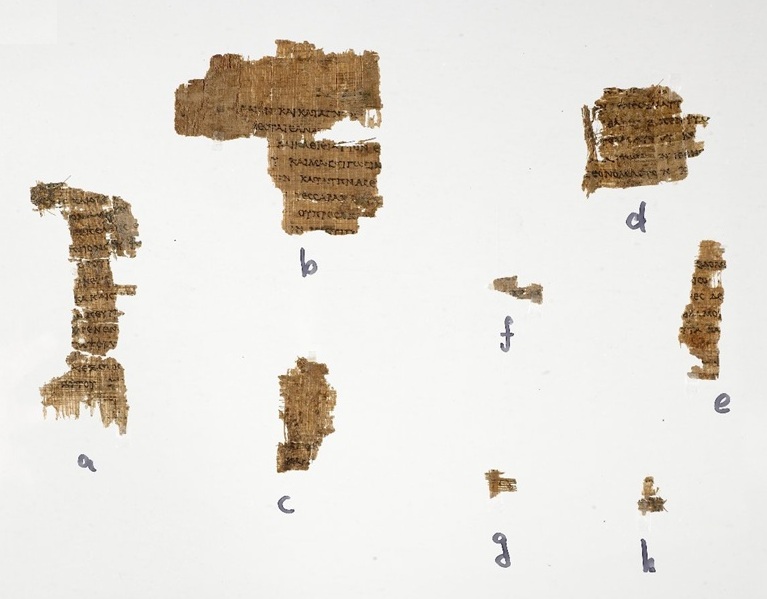by Dave Pocta -- San Antonio, Texas, USA
When we open our bibles, we often take for granted what is in front of us. For centuries, scribes and scholars have meticulously unearthed ancient texts. They have preserved, catalogued, studied and compared them to accurately provide us with God’s Word. This paper is a very brief introduction to the languages, textual traditions, early translations, and recent discoveries that laid the foundation for the blessing now known as the Old Testament.
Biblical Languages
The Hebrew bible (Old Testament) was originally written by several authors ranging from roughly the 15th to fifth century B.C. in the Hebrew language with small segments in Aramaic. (Primarily Daniel 2:4b-7:28 and Ezra 4:8-6:18, 7:12-26.) Aramaic was spoken by the Jews after the exile, which explains its appearance in these books with later dates. Documents in the original language are called manuscripts and copies of them are transmissions. Documents in other languages are called versions, as they are translations.

Example of Aramaic papyrus
Languages vary in communication style, flow, and structure. We would therefore prefer to possess the earliest manuscripts in the original language to ensure accuracy and avoid the translators’ interpretations. The two extremes in translation would be “word for word” translations which tend to be more literal but often can lose the exact meaning of the text, or “thought for thought” translations, which attempt to capture the meaning but lose the nuances of specific words. This makes evident the difficulty in translating a translation. For example, translating the Old Testament from Latin into English introduces the difficulties of moving across two language barriers instead of translating from Hebrew directly into English. The science of studying manuscripts to remove scribal copying errors and obtain the most likely original text is known as textual criticism. The intention of textual critics is to provide a precise original language text that can be used as a basis for translation into any language.
Textual Traditions
Ironically, the oldest manuscript of the complete Hebrew bible that we have is the Leningrad Codex (codex meaning ‘book’ as opposed to scroll), which is dated to 1008 A.D. Another important Hebrew codex is the Aleppo Codex, named after the city in Syria in which it was located. It was considered a model codex, used for Jewish high holidays and settling matters of dispute amongst scholars. Unfortunately, it was partially destroyed in a fire in 1947. Both of these come from a strong Jewish scribal tradition and are known as the Masoretic text. The Masoretes were a group of scholars that flourished between the 7th and 11th century A.D. They had meticulous practices of preserving the text and required the destruction of worn copies (They didn’t see the need for older copies because the text was firmly established.) They were also responsible for vowel pointing. The original Hebrew text was consonantal only. The Masoretes were concerned about the pronunciation of the language, as it wasn’t being spoken much anymore; and they added vowel pointing to preserve the proper way of reading the Hebrew.
Other portions and fragments of the Hebrew text have been found which have significantly earlier dates, such as the Nash Papyrus. It contains parts of Exodus 20 and Deuteronomy 5 and 6. Scholars debate its date. Some believe it was pre-exilic while others give it a first or second century A.D. date. These fragments serve as a snapshot of the early text. They provide some confirmation and some potential conflicts with the Masoretic text.
Early Translations
Even though we lack early complete Hebrew manuscripts, we have a number of early witnesses. These are translations that give us insight into the original text.
The Samaritan Pentateuch – Sometime after the exile, the Samaritans became an independent faction from the Jews. Their scriptures were written in a script variant of the Hebrew (called the Paleo-Hebrew script) and are now called the Samaritan Pentateuch. The Samaritan Pentateuch serves as a second Hebrew text of the Pentateuch and carries some six thousand variations from the Masoretic text. Most of these are orthographic (spelling differences) and some are additions that were introduced by the Samaritans to preserve their cult. (I.e. the command to build a sanctuary on Mount Gerizim was inserted after Exodus 20:17). It should be noted that about nineteen hundred variants agree with the Septuagint (see below) against the Masoretic text.
The Septuagint – Hellenism spread the Greek language as universal in the Diaspora. An Alexandrian Jew named Aristeas writes to his brother in the Letter of Aristeas that Ptolemy II Philadelphus, while serving as King of Egypt (281 B.C. to 246 B.C.), desired that his library have a copy of the Jewish Law. He sent to Eleazar, the High Priest, in Jerusalem for translators. Eleazar selected six elders from each of the twelve tribes and sent them with Hebrew scrolls to Ptolemy II. Supposedly, the seventy-two men translated the Pentateuch in seventy-two days on the island of Pharos; it was read to the Jews in Alexandria and approved as accurate. We aren’t sure how the rest of the Septuagint was translated, but we do know that it was done by multiple translators because parts of it tend to be literal (word for word) and other parts are more free (thought for thought). The Septuagint (abbreviated LXX, which means “according to the seventy”) is significant as it was widely recognized as the bible of the early church and many viewed the translation as inspired.

Fragments from Deuteronomy, manuscript of The Septuagint. John Rylands Library, Papyrus Greek 458
Other Early Translations – Language influences necessitated other translations for the Jews and early Christians. As previously noted, many post-exilic Jews spoke Aramaic. The Aramaic translation is known as the Aramaic Targums. The Syriac Translation is known as the Peshitta. The early Egyptian Christians read the Coptic Version. We also have the Ethiopic Version, the Armenian Version, and the Arabic Versions that bring perspective on the early text. Of special note is the Latin Vulgate. (Vulgate meaning “common language”) There were a number of Latin versions of the scriptures floating around the church by the fourth century A.D. Pope Damasus I commissioned Jerome, an eminently qualified scholar in Hebrew, Greek, and Latin, to translate a uniform and reliable text. Jerome’s Vulgate was pronounced the “authentic Bible of the Catholic Church” at the Council of Trent on April 8, 1546.
Recent Discoveries
With a basic understanding that the oldest complete Hebrew text we possess is from the early 11th century, we can now appreciate the significance of the discovery of the Dead Sea Scrolls. Stumbled upon by a shepherd boy in 1947, the eleven caves of the ancient Qumran community have yielded hundreds of manuscripts and fragments. The most significant find was a complete scroll of Isaiah that dates to the second century B.C.! This answers the accusation that the Isaiah messianic prophecies could have been written after Jesus’ life, as it pre-dates his birth. Fragments from every book in the Old Testament except for Esther have been found in the Dead Sea Scrolls.
Today’s Hebrew Bible
The Hebrew text that is primarily used today is the Biblia Hebraica Stuttgartensia (BHS). It was edited from 1967 to 1977, published by the German Bible Society, and its text is based on the Leningrad Codex. Its attached apparatus contains the notations of variants from different manuscript traditions. Many view the Aleppo Codex as the most authoritative codex of the Masoretic text. The Hebrew University in Jerusalem is in the process of producing an edition that will contain the exact reproduction of the Aleppo Codex as its foundational text and a significant apparatus with major variants from other sources. Thank God for the archeologists, linguists and scholars who have preserved the Holy Scriptures!
Bibliography
Bruce, F.F. The Canon of Scripture. Downers Grove: Intervarsity, 1988.
Geisler, Norman L., and William E. Nix. A General Introduction to the Bible. Grand Rapids: Eerdmans, 1986.
Jacoby, Douglas. How We Got the Bible (Audio Series). 2005.
Lightfoot, Neil R. How We Got the Bible. Third. Grand Rapids: Baker Books, 2003.
Soulen, Richard N., and R. Kendall Soulen. Handbook of Biblical Criticism. Third. Louisville, KY:
Westminster John Knox Press, 2001.
Wurthwein, Ernst. The Text of the Old Testament. Translated by Erroll F. Rhodes. Grand Rapids, MI: Eerdmans, 1995.
Photo Credits
1. Eduard Sachau, public domain; photo taken in 1909 of Aramaic papyrus containing a contract for a loan, dated to regnal year 5 of pharaoh Amyrtaios, in 400 BCE. From Elephantine (Upper Egypt), 28th Dynasty, Late Period. https://commons.wikimedia.org/wiki/File%3AAmyrtaios_aramaic_papyrus_Sachau.png
2. Manuscript of Septuagint with 8 fragments of the Book of Deuteronomy. From the 2nd Century B.C. Source: Papyrus Rylands 458. Public Domain, {{PD-UK-unknown}} {{PD-US}} https://commons.wikimedia.org/wiki/File%3AP._Rylands_458.jpg

